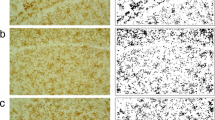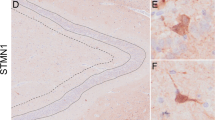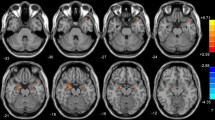Abstract
Although electroconvulsive therapy (ECT) has been used as a treatment for mental disorder since 1930s, little progress has been made towards understanding the mechanisms underlying its therapeutic and adverse effects. The aim of this work was to analyze the expression of NCS-1 (neuronal calcium sensor 1, a protein that was found to be altered in post-mortem prefrontal cortex of schizophrenic patients) in striatum, cortex, hippocampus and cerebellum of Wistar rats after acute or chronic electroconvulsive stimulation (ECS). Rats were submitted to a single stimulation (acute) or to a series of eight stimulations, applied one every 48 h (chronic). Animals were killed for collection of tissue samples at time zero, 30 min, 3, 12, 24 and 48 h after stimulation in the acute model and at the same time intervals after the last stimulation in the chronic model. Our results indicated that chronic ECS increased the expression of NCS-1 only in cerebellum. Such results on the expression of proteins involved in signaling pathways that are relevant for neuropsychiatric disorders and treatment, in particular ECT, can contribute to shed light on the mechanisms related to therapeutic and adverse effects.




Similar content being viewed by others
References
Kennedy R, Mittal D, O’Jile J (2003) Electroconvulsive therapy in movement disorders: an update. J Neuropsychiatry Clin Neurosci 15:407–421
Rosen Y, Resinik I, Sluvis A et al (2003) The significance of the nitric oxide in electro-convulsive therapy: a proposed neurophysiological mechanism. Med Hypotheses 60:424–429
Abrams R (1998) Electroconvulsive therapy. Oxford University Press, Oxford
The UK ECT Review Group (2003) Efficacy and safety of electroconvulsive therapy in depressive disorders: a systematic review and meta-analysis. The Lancet 361:799–808
Barichello T, Bonatto F, Agostinho FR et al (2004) Structure-related oxidative damage in rat brain after acute and chronic electroshock. Neurochem Res 29:1749–1753
Barichello T, Bonatto F, Feier G et al (2004) No evidence for oxidative damage in the hippocampus after acute and chronic electroshock in rats. Brain Res 1014(1–2):177–183
Burgoyne RD, Weiss JL (2001) The neuronal calcium sensor family of Ca2+-binding proteins. Biochem J 353:1–12
Kabbani N, Negyessy L, Lin R et al (2002) Interaction with neuronal calcium sensor NCS-1 mediates desensitization of the D2 dopamine receptor. J Neurosci 22:8476–8486
Souza BR, Souza RP, Rosa DVF et al (2006) Dopaminergic intracellular signal integrating proteins: relevance to schizophrenia. Dialogues in clinical neuroscience 7(4):95–100
Newman ME, Gur E, Shapira B, Lerer B (1998) Neurochemical mechanism of action of ECS: evidence from in vivo studies. J ECT 14:151–171
Bradford MM (1976) A rapid and sensitive method for the quantitation of microgram quantities of protein utilizing the principle of protein-dye binding. Anal Biochem 72:248–254
Towbin H, Staehelin T, Gordon J (1979) Electrophoretic transfer of proteins from polyacrylamide gels to nitrocellulose sheets: procedure and some applications. Proc Natl Acad Sci USA 76:4350–4354
Koh PO, Undie AS, Kabbani N et al (2003) Up-regulation of neuronal calcium sensor-1 (NCS-1) in the prefrontal cortex of schizophrenic and bipolar patients. Proc Natl Acad Sci U S A 100:313–317
Bai J, He F, Novikova SI et al (2004) Abnormalities in the dopamine system in schizophrenia may lie in altered levels of dopamine receptor-interacting proteins. Biol Psychiatry 56:427–440
Negyessy L, Goldman-Rakic PS (2005) Subcellular localization of the dopamine D2 receptor and coexistence with the calcium-binding protein neuronal calcium sensor-1 in the primate prefrontal cortex. J Comp Neurol 488:464–475
Augustine GJ, Santamaria F, Tanaka K (2003) Local calcium signaling in neurons. Neuron 40:331–346
Sippy T, Cruz-Martin A, Jeromin A et al (2003) Acute changes in short-term plasticity at synapses with elevated levels of neuronal calcium sensor-1. Nature Neurosci 6:1031–1038
Lisanby SH, Maddox JH, Prudic J et al (2000) The effects of electroconvulsive therapy on memory of autobiographical and public events. Arch Gen Psychiatry 57:581–590
Acknowledgements
This research was supported by grants from CNPq, FAPESC, Instituto Cérebro e Mente and UNESC to J. Quevedo; MVG and MAR-S are CNPq research fellows and RPS, BSM, FSC are holders of CNPq studentships and DVFR and BRS are holders of CAPESstudentships. Financial support from CNPq Universal grantproc. #471837/2004–0, Programa Institutos do Milênio/CNPq/FINEP andFAPEMIG # CBB-453/04
Author information
Authors and Affiliations
Corresponding author
Rights and permissions
About this article
Cite this article
Rosa, D.V.F., Souza, R.P., Souza, B.R. et al. NCS-1 Expression in Rat Brain after Electroconvulsive Stimulation. Neurochem Res 32, 81–85 (2007). https://doi.org/10.1007/s11064-006-9228-2
Received:
Accepted:
Published:
Issue Date:
DOI: https://doi.org/10.1007/s11064-006-9228-2




